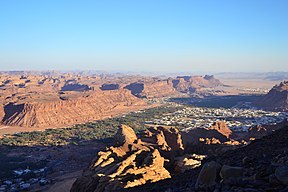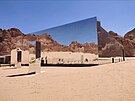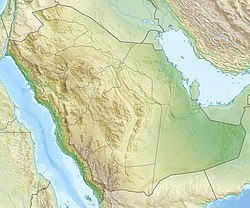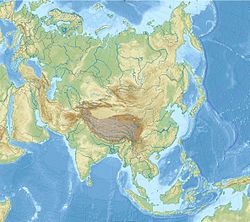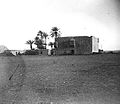al-Ula
Al-Ula
العلا | |
|---|---|
City | |
| Coordinates: 26°36′31″N 37°55′25″E / 26.60861°N 37.92361°E | |
| Country | |
| Province | Medina Province |
| Government | |
| • Body | Medina Municipality |
| • Governor of al-‘Ulā | Badr bin Abdullah |
| Area | |
| • Total | 22,561 km2 (8,711 sq mi) |
| Elevation | 692 m (2,270 ft) |
| Population (2022)[3] | |
| • Total | 60,103 |
| • Density | 2.7/km2 (6.9/sq mi) |
| Time zone | UTC+03:00 (AST) |
| Postal Code | (5 digits) |
| Area code | +966 014 |
| HDI (2021) | 0.875[4] – very high |
| Website | www |
| Official name | Hegra Archaeological Site (al-Hijr / Madā ͐ in Ṣāliḥ) |
| Type | Cultural |
| Criteria | ii, iii |
| Designated | 2008 (32nd session) |
| Reference no. | 1293 |
| Region | the Arab States |
Al-‘Ula (Arabic: ٱلْعُلَا, romanized: al-ʿUlā) is an ancient Arabian oasis city located in Medina Province, Saudi Arabia. Situated in the Hejaz, a region that features prominently in the history of Islam as well as several pre-Islamic Semitic civilizations, al-‘Ulā was a market city on the historic incense route that linked India and the Persian Gulf to the Levant and Europe.[5]
From an archaeological perspective, the immediate vicinity contains a unique concentration of precious artifacts, including well-preserved ancient stone inscriptions that illustrate the development of the Arabic language, and a concentration of rock dwellings and tombs that date from the Nabatean and Dedanite periods that coincided with Greco-Roman influence during classical antiquity. Saudi Arabia's first UNESCO World Heritage Site, Hegra (also known as al-Ḥijr, or Madā'in Ṣaliḥ), is located 22 km (14 miles) north of the city, in al-‘Ulā governorate. Built more than 2,000 years ago by the Nabataeans, Hegra is often compared with its sister city of Petra, in Jordan. Meanwhile, the ancient walled oasian city of al-‘Ulā, locally known as al-Dīrah, situated near the oasis' palm grove that allowed for its settlement, contains a dense cluster of mud-brick and stone houses.[6] al-‘Ulā was also the capital of the ancient Lihyanites (Dedanites).
Today, the city of al-‘Ulā is within the Governorate of al-‘Ulā (Arabic: مُحَافَظَة ٱلْعُلَا, romanized: Muḥāfathat Al-ʿUlā), one of seven constituent counties of Medina province. The city is located 110 km (68 miles) southwest of Tayma and 300 km (190 miles) north of Medina.[7] The city (municipality) covers 2,391 square kilometres (923 sq mi),[8] and has a population of 60,103 as of 2022[update].[9][8] In addition to the ancient old town al-Dīrah, a more recent historical and adjacent settlement, al-Judaydah, displaying the settlement patterns of Arabic-Islamic urbanism, remains occupied and is currently experiencing a redesign. Since the 1980s, the oasis of al-‘Ulā has experienced significant agricultural and urban growth. Since then, the settled Bedouins have been added to the population of Sedentary people and, as in the rest of the kingdom, a large population of immigrant workers.[10]
The area is also known for its striking landscape of rocks, canyons, and wadis, and the contrast between these dry surroundings and the lush, palm-filled oases near the city's centre. The oasis of al-‘Ulā was once a key stop on the Hejaz Railway, linking Damascus to Medina.
History
[edit]The oasis of al-‘Ulā has had permanent human settlement since 5000 BCE, through the Bronze Age.[11]
The walled city of al-‘Ulā was founded as an oasis in the desert valley, with fertile soil and plenty of water. It was located along Incense trade route, the network of routes that facilitated the trading of spices, silk and other luxury items through the Kingdom of Aksum, Arabia, Egypt, and India. The oasis of al-‘Ulā stands on the site of the Biblical city of Dedan but was founded with the ancient North Arabian kingdom of Lihyan, which ruled from the 5th to 2nd century BCE.[12] The older history of the oasis has been divided into several phases. The Dedanite kingdom spans the 7th and 6th centuries BCE. Dedan is mentioned in the Harran Stela. In these it is told how Nabonidus, last ruler of the Neo-Babylonian Empire, made a military campaign to northern Arabia in 552 BCE or somewhat later, conquering Tayma, Dedan, and Yathrib (now Medina).[13] It is thought that around the turn of the 5th century BCE, the kingdom became hereditary.
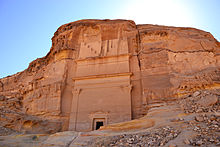
The next four hundred years, until around 100 BCE, was the period of Liḥyanite kingdom. The Nabataeans were also the lords of the region at least until 106 CE, when the Roman Empire conquered and annexed it in their Arabia Petraea province.[14]

Al-Mabiyat, some 20 km (12 miles) away near Mughayrah became the next commercial centre of the region. It thrived from around 650 CE until it declined at some time before 1230. In the 13th century, the old city of al-‘Ulā, locally known as al-Dīrah, was built, and many stones of the old Dedanite and Lihyanite ruins were reused. The oasis of al-‘Ulā now became the major settlement of the region again until modern times. Between 1901 and 1908 the Ottomans built the Hejaz railway in order to link Damascus to Medina. The railway had main stations in both Madā'in Ṣaliḥ (Hegra) and al-‘Ulā, where a line was built through the western part of al-Khuraybah, some 12 km (7.5 miles) to the north of the old medieval town, which is believed to be the site of the old Dedanite and Lihyanite town that is still standing there despite being in bad shape.[citation needed]
In the 20th century, the new town centre was established beside the old town, and eventually, the people left the old buildings. The last family is said to have gone in 1983, while the last service in the old mosque was held in 1985.[15] Both the ruins of the medieval town al-Dīrah and the site of the Liyhanite settlement now lie within the limits of the modern town.
The most detailed study of the area was made by the French priests Antonin Jaussen and Raphaël Savignac, who visited the area three times, in 1907, 1908 and 1910. They studied the remains at Hegra and Dedan and collected a large number of Lihyanite, Minaean, Thamudic, and Nabataean inscriptions. Accordingly, it was their work that came to constitute the basis for all further study and research in the area's history.[16]
The first European traveller of modern times to describe the town was Charles Doughty in 1876. Charles Huber was in al-‘Ulā in 1881–1882. He returned in 1883 accompanied by Julius Euting. In 1968 a team of archaeologists from the University of London investigated 15 inscriptions.
The vertical sandstone cliffs surrounding the valley provide ample surfaces for rock art, making the governorate one of the richer petroglyph regions in the Kingdom. Ar-Ruzeiqiah is a mountain in the southern part of the governorate, with a large petroglyph panel displaying hundreds of images, including depictions of hunting scenes with humans and a variety of animals. Ibex are the most common species but camels, horses and other species can also be found. Mount Ikma also has a large façade with scenes, strange symbols, and inscriptions.[17]
Timeline
[edit]Here is the sequence of historical events and the ancient evidence found in the al-‘Ulā governorate:[18]
| History | Evidence |
|---|---|
| Bronze Age |
|
| Ancient North Arabian Kingdoms (DEDAN) |
|
| Nabataean Kingdom (Hegra) |
|
| Roman presence |
|
| Islamic period (QURH, al-‘Ulā) |
|
| Ottoman presence |
|
Administration
[edit]There are four major municipalities in the Governorate of al-‘Ulā: al-‘Ulā, the capital lying to the southwest (population 5,426); Mughayrāʾ (Arabic: مُغِيْرَاء) to the southeast (population 8,952); Abu Raku, to the north (population 2,678); and al-Ḥijr to the northeast (population 1,707).[8]
Heritage Village
[edit]al-‘Ulā Heritage Village, also known as Al-Dīrah, is the traditional Arabian village to which people of the oasis moved some eight centuries ago and inhabited until the 20th century. It was built on a higher part of the valley in order to be clear of the floods that can occur during the rainy season. At its maximum expansion the town contained more than 1000 houses, which were built adjacent to one another, thereby forming a wall around the town to defend the population. On the west of the town, at the bottom of the cliff, is the old souq, which has been renovated.[19]
Royal Commission for Al-Ula
[edit]The importance of al-‘Ulā as an archaeological and historic site led to the establishment of The Royal Commission for Al-Ula (RCU) in July 2017, the aim of which is to develop and promote al-‘Ulā as an international tourism destination.[20] Moreover, the commission develops the plans for heritage conservation and preservation.[21] The Royal commission for Al-Ula, along with Al-Ula Development Company, have taken various development projects in the region, including the five districts planned for al-‘Ulā by 2030. The five districts include: al-‘Ulā old town, Dadan, Jabal Ikmah, Nabataeane Horizen, and Hegra Historical City. These five districts are part of a larger development plan for al-‘Ulā that further aims to transform the city into a world-class tourist destination while also preserving its cultural and historical heritage.[22]
Development plan
[edit]To promote tourism and gain more attraction, the Royal Commission on Al-Ula is training 200 young Saudis on an ambitious project where tourists will explore the area's cultural treasures. Recruited from the al-‘Ulā region, the 200 young people (all high-school age or in their first year as university students, and split equally between boys and girls) are in Riyadh, Saudi Arabia being trained in hospitality, learning new languages, studying farming and water technology, and researching the cultural, social and natural history of their home region.[23]
In January 2023, the Public Investment Fund launched Al-Ula Development Company, a hospitality and real estate developer which aims to turn al-‘Ulā into a global tourist destination.[24]
Al-Ula International Airport
[edit]Al-Ula International Airport was a crucial part of the development strategy of the Royal Commission for Al-Ula (RCU), which envisioned making it a global destination for culture and tourism. In March 2021, the airport was approved to receive international flights, along with an increased capacity of receiving 15 commercial flights at a time. The capacity was increased from 100,000 to 400,000 passengers per year.[25][26]
Tourism
[edit]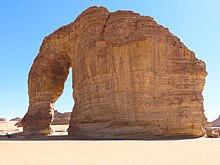
The Saudi Arabian government is collaborating with experts from around the world on the al-‘Ulā development. In April 2018 it signed a 10-year deal with France that included provisions for hotels, transport infrastructure and a world-class culture and art museum.[27] Since 2021, the Royal Commission of Al-Ula has been running SME accelerator in collaboration with AstroLabs to ensure growth of the local tourism ecosystem.[28] With this program, the region has set out on an ambitious mission to welcome 2 million tourists and contribute SAR 120Bn to the national GDP by 2030.[29]
A major integrated archaeological survey of al-‘Ulā valley and beyond was launched by the commission, charged with protecting and regenerating the north-western region. While a conservation and development plan was established, some of the sites including the World Heritage Site of Madā'in Ṣaliḥ were closed to the public, but have been open since 2020 for visitors.[30]
With the easing of visa process for international travelers, al-‘Ulā attracts more tourists from abroad.[citation needed] Its most popular sites are: al-‘Ulā Old town, Oasis Heritage Trail, Hegra UNESCO Heritage Site, Dadan, Jabal Ikmah, Jabal AlFil (Elephant Rock), Harrarat Viewpoint or Maraya. Travelers from around the world can also enjoy numerous of activities such as stargazing, desert dune bashing, desert campaign, hiking, biking, rock climbing, via ferrata and others.[31]
Accommodation in al-‘Ulā
[edit]
As the tourism infrastructure, aiming tourism de luxe, is still being developed in al-‘Ulā, finding an affordable accommodation can be a challenge during high season. Tourists have a variety of options ranging from camping sites, holiday homes (apartments or chalets) to luxury resorts. As of 2023[update], al-‘Ulā is home to 10 luxury resorts and accommodations available for visitors of the old city.[citation needed]
"Winter at Tantora" festival
[edit]
Winter at Tantora was a traditional celebration to mark the start of the 40-day winter growing season. The name of the festival, 'Tantora', is inspired by a sundial located in the old town of al-Ula, which has been in use by the locals as a marker for the changing of the seasons.[32] On 20 December 2018, the first "Winter at Tantora" started with a series of different themed weekend events including music, arts, entertainment, and cultural events. The concerts were performed in Maraya Concert Hall, which was newly constructed for this purpose,[33] and whose external walls are covered with mirrors, maraya being the Arabic word for 'mirrors'.[34] A second edition of Winter at Tantora Festival was held on 19 December 2019, and included performances by Omar Khairat, EBI "Ebrahim hamedi", Andrea Bocelli, Yanni, Enrique Iglesias, and Lionel Richie.[35]
On 26 December 2019, Maraya Concert Hall set a Guinness World Record for the largest mirrored building in the world, in which it was covered by 9,740 square metres (104,800 sq ft) of mirrored façade.[36]
Azimuth Festival
[edit]As part of the "Winter at Tantora" festival, Saudi Arabia hosted a three-day festival of music, art and food. Held between 5–7 March 2020, the Azimuth Festival was an event that brought the east and west together at al-‘Ulā. It marked performances from artists like the Chainsmokers, Jean-Michel Jarre, Tinie Tempah and others.[37] The event took place at the beginning of the COVID-19 pandemic, and so received only little publicity.
Persian Night in Saudi Arabia's Al-Ula
[edit]From 6 to 7 March 2020, a large concert of Iranian singers was held at the winter celebration of the Kingdom of Saudi Arabia in the city of al-‘Ulā. Ebi, Leila Forouhar, Shahram Shabpareh, Shadmehr Aghili, Andy (Andranik Madadian), Arash and Sasy were present at the concert.[38]
al-Ula Vision
[edit]On 11 February 2019, Saudi Arabia's Crown Prince Mohammed bin Salman launched the al-Ula vision which features a resort and nature reserve called Sharaan.[39] The vision also includes the establishment of the Global Fund for the protection and revitalization of the Arabian leopard.[40] Al Ula provides an opportunity for numerous international companies to benefit from the ambitious plans. Some notable companies are already working on and benefiting from the AlUla project: AECOM, JAL International, Nesma & Partners, Alstom, KUN Investment Holding and others.[41]
Climate
[edit]| Climate data for al-‘Ulā (Prince Abdul Majeed bin Abdulaziz International Airport) (1991–2020) | |||||||||||||
|---|---|---|---|---|---|---|---|---|---|---|---|---|---|
| Month | Jan | Feb | Mar | Apr | May | Jun | Jul | Aug | Sep | Oct | Nov | Dec | Year |
| Record high °C (°F) | 25.8 (78.4) |
30.3 (86.5) |
34.7 (94.5) |
38.4 (101.1) |
41.4 (106.5) |
47.0 (116.6) |
47.5 (117.5) |
44.8 (112.6) |
43.8 (110.8) |
40.2 (104.4) |
34.4 (93.9) |
28.2 (82.8) |
47.5 (117.5) |
| Mean daily maximum °C (°F) | 20.0 (68.0) |
24.3 (75.7) |
28.6 (83.5) |
33.3 (91.9) |
38.5 (101.3) |
41.3 (106.3) |
43.0 (109.4) |
42.1 (107.8) |
42.0 (107.6) |
36.9 (98.4) |
28.3 (82.9) |
24.4 (75.9) |
33.6 (92.5) |
| Daily mean °C (°F) | 13.4 (56.1) |
17.2 (63.0) |
22.0 (71.6) |
26.1 (79.0) |
31.3 (88.3) |
34.5 (94.1) |
36.1 (97.0) |
35.1 (95.2) |
35.5 (95.9) |
30.0 (86.0) |
22.0 (71.6) |
17.7 (63.9) |
26.8 (80.2) |
| Mean daily minimum °C (°F) | 6.3 (43.3) |
9.3 (48.7) |
15.3 (59.5) |
19.0 (66.2) |
23.7 (74.7) |
27.0 (80.6) |
29.3 (84.7) |
28.1 (82.6) |
27.7 (81.9) |
21.4 (70.5) |
16.1 (61.0) |
11.9 (53.4) |
19.6 (67.3) |
| Record low °C (°F) | 2.0 (35.6) |
4.0 (39.2) |
10.2 (50.4) |
12.7 (54.9) |
18.8 (65.8) |
20.6 (69.1) |
24.2 (75.6) |
24.7 (76.5) |
20.1 (68.2) |
17.6 (63.7) |
9.0 (48.2) |
8.7 (47.7) |
2.0 (35.6) |
| Average precipitation mm (inches) | 3.7 (0.15) |
0.0 (0.0) |
19.0 (0.75) |
0.0 (0.0) |
0.0 (0.0) |
0.0 (0.0) |
1.5 (0.06) |
0.0 (0.0) |
0.5 (0.02) |
0.0 (0.0) |
26.3 (1.04) |
9.9 (0.39) |
60.9 (2.40) |
| Average precipitation days (≥ 1.0 mm) | 1.0 | 0.0 | 1.0 | 0.0 | 0.0 | 0.0 | 0.0 | 0.0 | 0.0 | 0.0 | 2.0 | 1.0 | 5.0 |
| Source: NOAA[42] | |||||||||||||
Gallery
[edit]-
Hegra Roman inscription dedicated to Emperor Marcus Aurelius
-
Two colossal statues from the sanctuary of Dadān/al-Khuraybah, possibly figurative representations of Lihyanite kings
-
Petroglyphs with human figures, ostriches and dogs
-
Rock pool at Banyan Tree Al-Ula
See also
[edit]- Al-Ula Development Company
- Sarat Mountains
- Hijaz Mountains
- Hijaz Railway
- Mawqaq
- Team Jayco–AlUla, a cycling team partly sponsored by the city
- The temple of Mahlab al-Naqa
- Al-Ula FC
- Al-Ahsa Oasis
References
[edit]- ^ محافظة اللا [Governate of Al-Ula]. Madinah Investments (in Arabic). Retrieved 6 May 2024.
- ^ "Elevation Finder". www.freemaptools.com. Archived from the original on 20 April 2020. Retrieved 14 May 2021.
- ^ "GASTAT Portal" بوابة الهيئة - الصفحة الرئيسية. portal.saudicensus.sa (in Arabic). Archived from the original on 3 October 2023. Retrieved 4 May 2024.
- ^ "Sub-national HDI – Subnational HDI – Global Data Lab". Archived from the original on 3 June 2024. Retrieved 4 May 2024.
- ^ "Heritage Sites in Al-'Ula, Saudi Arabia | ExperienceAlUla.com". experiencealula.com. Retrieved 3 June 2020.[permanent dead link]
- ^ Chowdhury, Arka Roy (16 April 2018). "Saudi Arabia is planning to open the region of Al-'Ula for tourists". The Times of India. Archived from the original on 15 January 2019.
- ^ محافظة العلا في السعودية [Al-Ola Governorate in Saudi Arabia]. موسوعة المحيط [The Encyclopedia of the Ocean]. 11 August 2018. Archived from the original on 1 August 2021. Retrieved 15 January 2019.
- ^ a b c العلا.. عروس الجبال.. عاصمة الآثار.. مدينة الأربعين عينًا [Al-ʿUla .. Bride of the mountains .. The capital of monuments .. The city of forty Ain]. Al Madina. 1 December 2013. Archived from the original on 13 January 2018. Retrieved 10 May 2019.
- ^ "Places in Al-'Ulā (Medina Region, Saudi Arabia) - Population Statistics, Charts, Map, Location, Weather and Web Information". www.citypopulation.de. Archived from the original on 3 March 2024. Retrieved 3 March 2024.
- ^ Battesti, Vincent; Marty, Léo (2023). "Bedouins and Sedentaries today in al-'Ulâ (Kingdom of Saudi Arabia): al-diyâr and al-Dîra in the rear-view mirror". Arabian Humanities. 17. doi:10.4000/cy.10103. ISSN 2308-6122.
- ^ "Dedan". Livius. Archived from the original on 31 August 2023. Retrieved 23 August 2023.
- ^ "Al 'Ula". Archived from the original on 13 June 2023. Retrieved 23 December 2018.
- ^ Gadd, C. J. (1958), The Harran Inscriptions of Nabonidus, vol. 8, Anatolian Studies, p. 59
- ^ "The History of Hegra - Hegra Conservation Project". 12 September 2024. Archived from the original on 24 September 2024. Retrieved 24 September 2024.
- ^ Modern Al-Ula Archived 23 July 2011 at the Wayback Machine at Madainsale.net.
- ^ Al-Nasif, Abdallah (1981). "Al-'Ula (Saudi Arabia): A Report on a Historical and Archaeological Survey". Bulletin (British Society for Middle Eastern Studies). 8 (1): 30–32. doi:10.1080/13530198108705304. JSTOR 194675.
- ^ "Al Ula - Arabian Rock Art Heritage". Archived from the original on 28 May 2019. Retrieved 23 December 2018.
- ^ "About AlUla". rcu.gov.sa. Archived from the original on 20 May 2024. Retrieved 20 May 2024.
- ^ "Al-'Ula". Saudi Arabia Tourism Guide. 14 September 2017. Archived from the original on 12 January 2020. Retrieved 23 December 2018.
- ^ "King Salman Appoints Commissions to Develop Al-Ola and Diriyah Gate into Major Tourist Attractions". www.businesswire.com. 25 July 2017. Retrieved 11 February 2019.
- ^ "الهيئة الملكية لمحافظة العلا - Royal Commission for Al-'Ula". twitter.com. Archived from the original on 27 March 2019. Retrieved 11 February 2019.
- ^ "AlUla | 5 Districts of Journey Through Time". ucl.rcu.gov.sa. Archived from the original on 6 June 2023. Retrieved 15 June 2023.
- ^ "A new era dawns for Saudi Arabia's ancient cities of Al-'Ula". Arab News. 9 April 2018. Archived from the original on 28 December 2018. Retrieved 23 December 2018.
- ^ Oxborrow, Ian (30 January 2023). "PIF-owned AlUla Development Company launched to turn tourism site into global destination". The National News. Archived from the original on 18 March 2024. Retrieved 19 March 2024.
- ^ "Al-'Ula Airport Starts Receiving International Flights". Asharq AL-Awsat. Archived from the original on 5 March 2021. Retrieved 5 March 2021.
- ^ "Saudi Arabia to allow international flights to land at Al-'Ula airport - SPA". Reuters. 4 March 2021. Archived from the original on 4 March 2021. Retrieved 4 March 2021.
- ^ "France to help build a 'new Petra' in Saudi Arabia with estimated $20bn development deal". www.theartnewspaper.com. 9 April 2018. Archived from the original on 30 September 2020. Retrieved 3 June 2020.
- ^ "ASTROLABS PARTNERS WITH ROYAL COMMISSION FOR ALULA TO ACCELERATE BUSINESS TRANSFORMATION UNDER SAUDI VISION 2030". www.startupmagazine.co.uk. 15 January 2023. Archived from the original on 18 February 2023. Retrieved 18 February 2023.
- ^ "SMEs Drive Global Tourism: Modern businesses showcasing heritage". AstroLabs. 17 January 2023. Archived from the original on 22 February 2023. Retrieved 22 February 2023.
- ^ "New drive to showcase the treasures of Saudi Arabia's ancient city of Al-'Ula". Arab News. 3 May 2018. Archived from the original on 12 December 2018. Retrieved 23 December 2018.
- ^ "The Ultimate Traveler's Guide to Al Ula, Saudi Arabia". Everywhere We Go. 5 February 2023. Retrieved 18 February 2023.
- ^ "About Al-'Ula". www.winterattantora.com. Archived from the original on 30 July 2019. Retrieved 5 February 2019.
- ^ Nihal, Mariam (16 January 2019). "Winter at Tantora Festival announced in Al-'Ula". Saudigazette. Archived from the original on 28 July 2021. Retrieved 5 February 2019.
- ^ "Saudi Arabia's Maraya Concert Hall: An architectural wonder of the world". Arab News. 18 March 2020.
- ^ "Winter at Tantora Festival: See Al-'Ula's Culture Come to Life". experiencealula.com. Archived from the original on 16 June 2020. Retrieved 3 June 2020.
- ^ "Largest mirrored building". Guinness World Records. 26 December 2019. Archived from the original on 14 January 2021. Retrieved 9 October 2020.
- ^ "What is Al Ula's Azimuth Festival? Three-day event coming to Saudi Arabia in March". The National News. 12 February 2020. Archived from the original on 2 January 2020. Retrieved 12 February 2020.
- ^ "Iranian singers perform at historic 'Persian Night' in Saudi Arabia's al-Ula". english.alarabiya.net. Archived from the original on 6 March 2020. Retrieved 6 March 2020.
- ^ "Launching the Vision for Saudi Arabia's ancient Al-Ula city". Arab News. 10 February 2019. Archived from the original on 11 February 2019. Retrieved 11 February 2019.
- ^ "'Al Ula Vision... Saudi Arabia gift to world'". Saudigazette. 11 February 2019. Retrieved 11 February 2019.
- ^ "AlUla - A Giga Project of Cultural and Economic Significance in Saudi Arabia". Setupinsaudi.com. 10 February 2019. Archived from the original on 13 August 2024. Retrieved 13 August 2024.
- ^ "World Meteorological Organization Climate Normals for 1991-2020 — al-'Ulā". National Oceanic and Atmospheric Administration. Archived from the original on 6 February 2024. Retrieved 6 February 2024.
Further reading
[edit]- Abdul Rahman Ansary, Ḥusayn Abu Al-Ḥassān, The civilization of two cities: Al-ʻUlā & Madāʼin Sāliḥ, 2001, ISBN 9960-9301-0-6, ISBN 978-9960-9301-0-7
External links
[edit]![]() Media related to Al-'Ula at Wikimedia Commons
Media related to Al-'Ula at Wikimedia Commons
- Royal Commission for AlUla website
- The Ultimate Traveler's Guide To Al Ula, Saudi Arabia
- Al Ula and its ancient civilsations
- The Incense Road
- Arab Resorts Areas Company – Al Ula ARAC Hotel
- "AlUla Manara and AlGharameel Nature Reserves officially named as Saudi Arabia's and GCC's first-ever Dark Sky Park in boost to astronomy and astrotourism ambitions", DarkSky International (3 October 2024)
- Uncovering secrets of mystery civilization in Saudi Arabia – BBC
- Experience Alula

